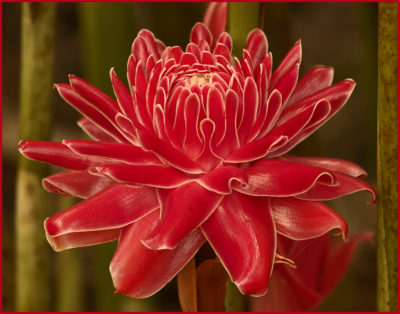
Ginger flower.
The farangs, Thai word for outsider, are home. Luggage is stashed, laundry done: trip details fade into the background and life as we know it resumes. Before memory fails with the passage of time (a shorter and shorter window with advancing age), we’d like to give an overall impression of SE Asia on our first visit to the area. Most of our time was spent in Thailand and Laos, with a brief visit to Cambodia. We saw nothing of Vietnam.
We’d certainly heard about what economic powerhouses the SE Asian countries have become, but were unprepared for the ferocity of unfettered capitalism. People exploit the tiniest niches in order to survive. Whether a monarchy, military or communist government is in charge, it is hard to tell any difference at street level. We were told there are many laws, but apparently they are seldom enforced. Vendors cover nearly every square inch of sidewalk space in the cities, and roadside stands line miles of the highways. Ancient and modern lifestyles and fashions co-exist side by side.
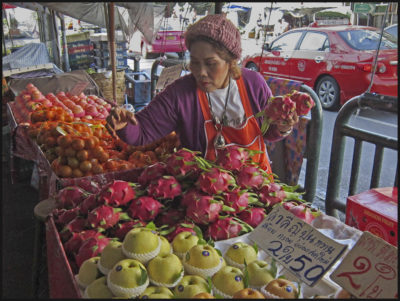
Street vendors line every busy thoroughfare.
Food choices are entertaining.
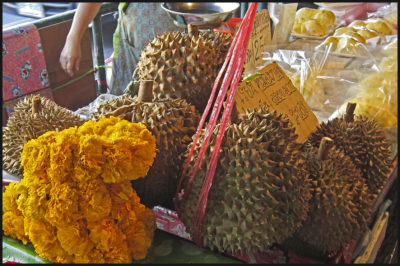
Many more creatures and plants are considered food items in these countries… Insects like grubs, grasshoppers and scorpions, were new to us although we can’t say we tried any.
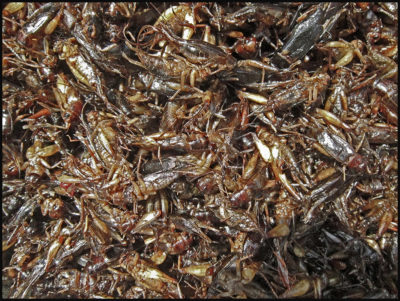
Fried grasshoppers.

Dried fish on the street.
We did try various fruits and vegetables, and found them delicious.
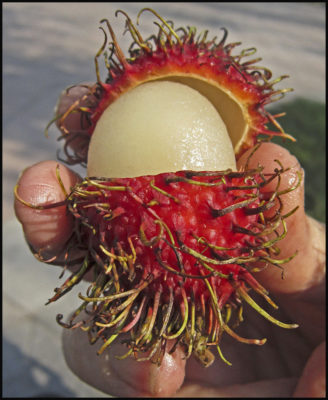
Our favorites, rambutans.
One marketing technique we questioned was the vendors in a certain area all selling an identical product. For example, along the roads we would pass dozens of pineapple vendors, further along would be basket sellers, and then later hoards of people selling salt, etc, etc. If you wanted to buy, say, a banana, forget it…go to the banana stand in a local market. This keeps prices very low as competition is fierce. I’m sure they have their reasons, but since we don’t speak the language, we couldn’t ask. However, the food supply seems copious and the population looks generally well fed. Certainly not over-fed, but healthy. We saw very few truly pathetic looking people. Unfortunately dental care appears minimal. Many still chew betel nut in the rural villages, so the teeth that are left, are red-stained. Cultural differences are fun to observe.
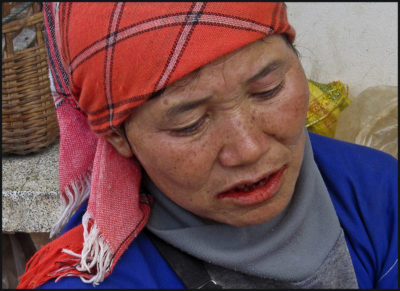
Many people chew betel nut which leaves teeth and lips bright red.
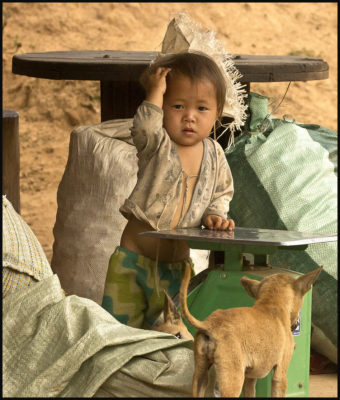
Northern village child.
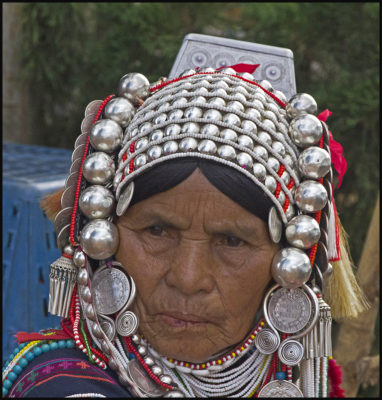
Akha clan woman.
Thailand exports the more rice than any country in the world. However, rice is the staple of every meal so obviously a lot stays in the country. Rice paddy cycles still dominate rural life. In some areas where water is abundant, two crops a year are grown, but mostly only one. Water buffalo are the plows of choice in the paddies, although tractors are making inroads. You don’t need to feed a tractor all year, but the price of a tractor is steep versus letting buffalo (or cattle) feed in the paddies once the harvest is over.
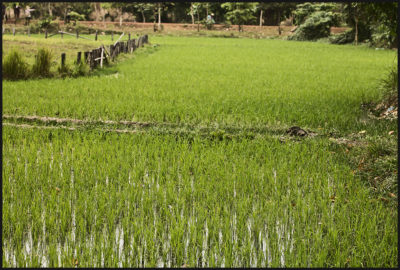
Flooded paddy.
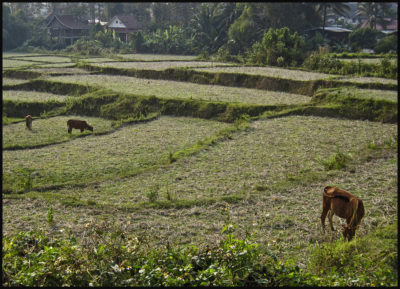
Dry paddies become pastures.

Welder.
Before we leave the commerce topic, we want to comment on the freedoms these people have. They can do basically anything short of killing someone, and we aren’t altogether sure about that.
Libertarians take note. Freedoms we once enjoyed in this country are all available here; like stuffing 20 children in the back of a pick-up, or riding motorbikes with no helmet and 3 children on board, or swimming in polluted rivers, or throwing trash anywhere, or privately selling gasoline in liter bottles, or shooting anything that moves that might be edible, etc. etc. There are no child labor laws. Families take care of their own as the safety net is minimal.

Four on a bike.
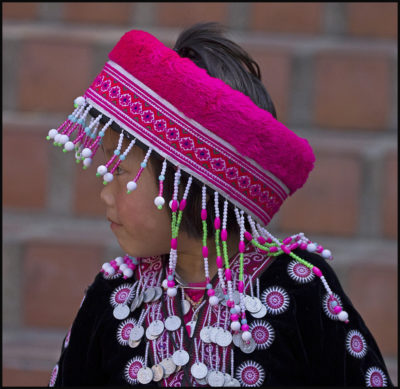
Children work to support their family.
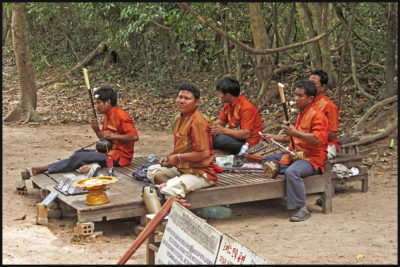
Safety net is limited.
No government agencies check on the cleanliness of food vendors, restaurants or farms. Pesticides are used with no oversight. Big corporations cut the forests at alarming rates and don’t worry about silted up streams, dead fish, or flooding. Environmental standards are nearly non-existent and the few people that care are likely fighting a losing battle. Wildlife is scarce in populated areas. Birds are caught and eaten or sold to the pet trade.
China is the biggest player in this neighborhood. It doesn’t seem to demand much environmental oversight in its vendors.
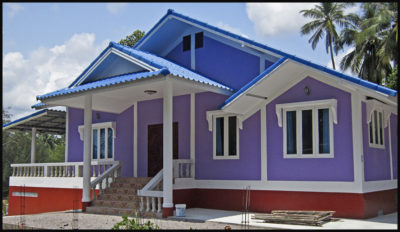
Example of new construction.
The rich are doing very well and building new houses. Some are building colorful new homes right in front of the old open-air, wooden ones which are still being used too.
In Thailand a robust middle class is emerging. All the rest are scraping by. In Laos and Cambodia the middle class is struggling to get a foothold. After years of war in these countries, life is still very hard and median income very low.
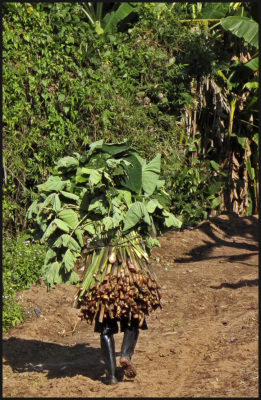
Daily life is difficult for most.
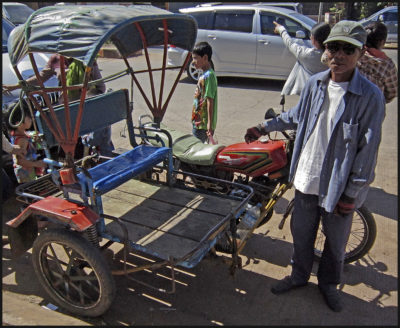
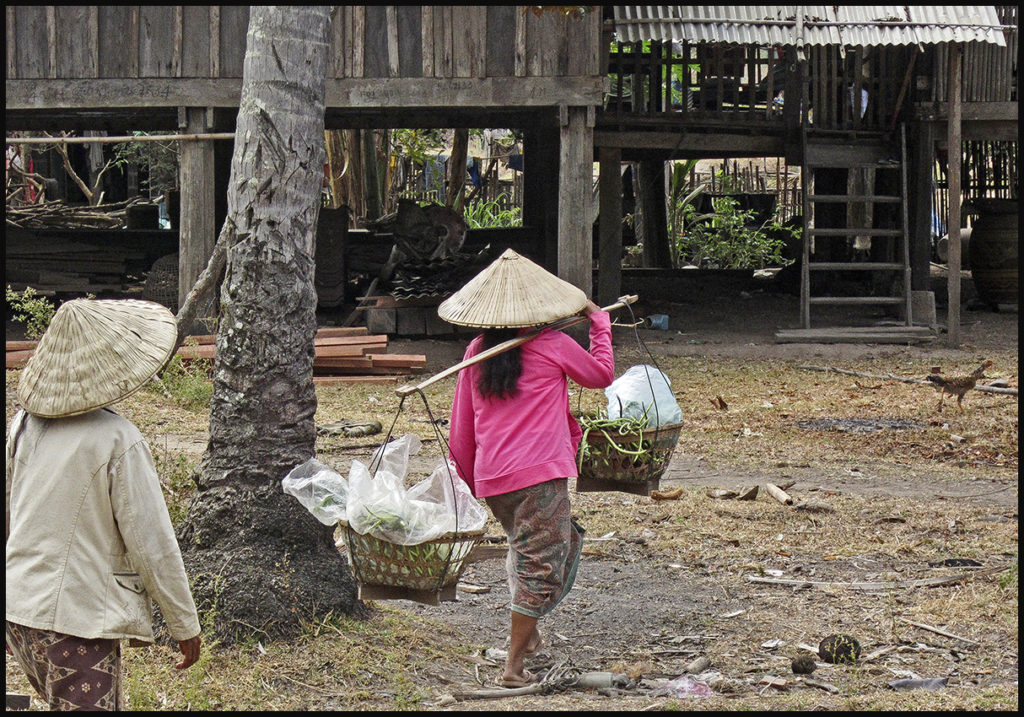
Home from shopping.
In the dry season, when tourists like to visit, farmers burn the fields which results in nearly unbreathable air.
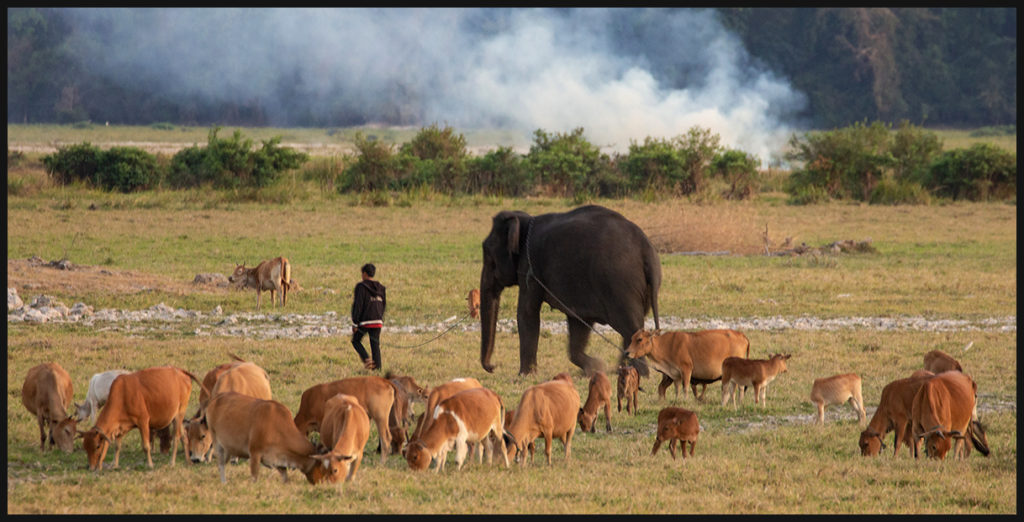
Burning fields ruin air quality.
In the cities, the smog from unregulated tailpipe emissions and the smoke drifting in from the farmlands makes a toxic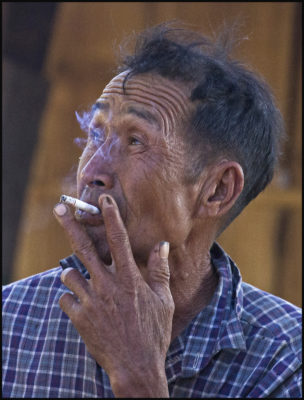 brew. Add to that the sewage scents wafting from the barely covered sluices running along the streets and you get an idea of the air quality. On top of all that, nearly everyone smokes cigarettes!
brew. Add to that the sewage scents wafting from the barely covered sluices running along the streets and you get an idea of the air quality. On top of all that, nearly everyone smokes cigarettes!
Mosquito borne diseases like malaria and dengue, and other water related tropical problems take their toll on the natives. (Luckily, during the dry season we saw very few mosquitoes.)
We find it hard to believe so many reach old age. These folks are tough.
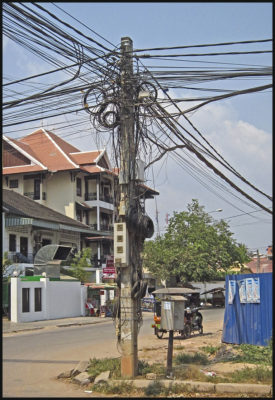
Part of the power problem.
New construction is noticeable. Construction costs are low. Maintenance is often neglected, perhaps because building anew is so cheap.
Electric power is intermittent but basically reliable. Poles on the streets tell the tale. Power grids for the fastest growing cities are lagging. While we were in Seam Reap, Cambodia, the power was only available a few hours a day. Polluting, makeshift generators fill the gap and keep businesses running.
Wifi is available everywhere except the most rural areas. Cell phones are rife. Even the poorest hill tribes have cell connection and personal phones.
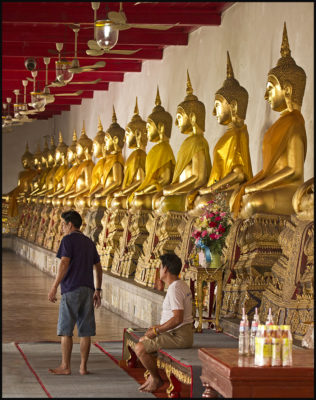
Buddhism rules.
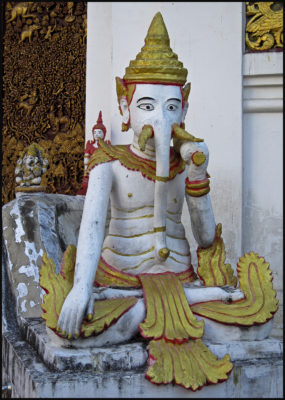
Ancient Hindu influences are rife.
Religion is part of everyday life in these countries. While most are Buddhist, there are some Christians, Muslims, and minor sects. The Buddhism practiced is a sort of mash-up of the original Hindu and Buddhist influences imported from India many millennia ago. At least that’s how it appears to us…no resemblance to the Zen Buddhism we are familiar with. When visiting a temple all must remove their hats and shoes, wear appropriate clothing covering upper arms and legs, and never let the soles of one’s feet face the Buddha.
Monks are a powerful force balancing the military and in Thailand’s case, the monarchy. So much time and money is lavished on the temples and shrines it is amazing; even awesome, especially for poor countries.
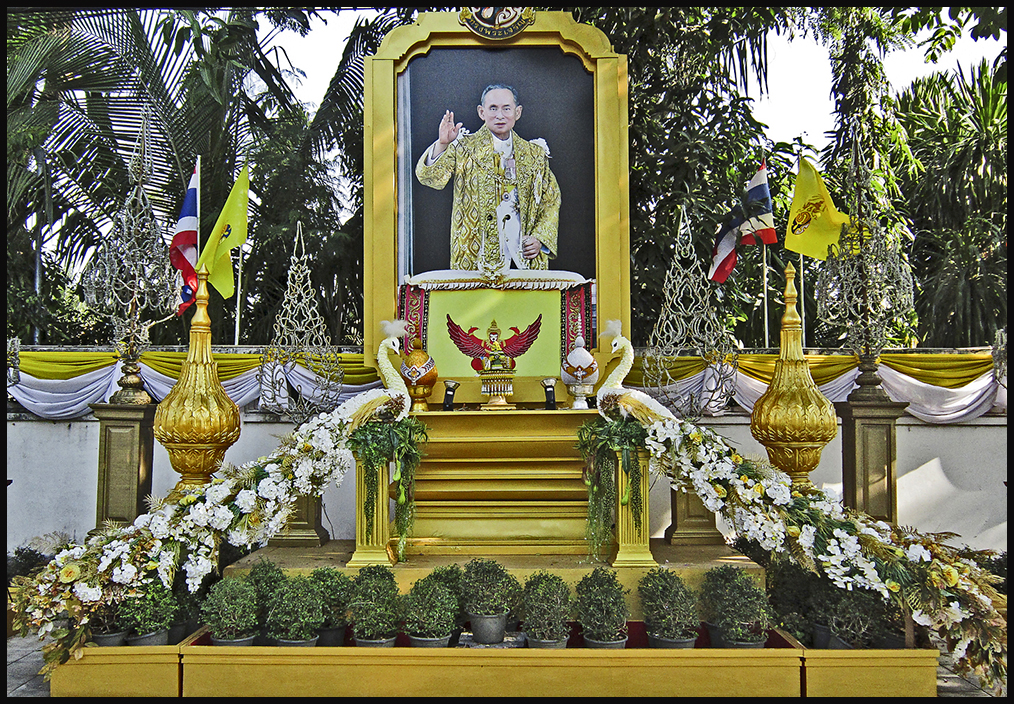
Now that the king is gone, the military and monks control most power. I wonder if the ubiquitous pictures of the king are still everywhere.
Job creation in over-populated countries is a problem they solve by hiring a lot of people to do what in this country would be one job. Wages are low but several people eke out a living sharing an often boring job. These are not the highly skilled jobs. These are the ones held by the people tourists interact with most often. This can be frustrating, as many are not highly motivated or competent, but most try very hard to please.
Traveling by public transport is an experience all its own. There are so many choices for short hops or long distance. It all depends on one’s spirit of adventure, flexibility and pocketbook.
In the cities there are inexpensive tuk-tuks, and the even less expensive collectives. For exploring rural areas near urban areas, there are motorbikes for rent. For longer distances in ascending price order one can choose the transport locals use, pronounced songtau which stop frequently, public buses which are “rustic” and take their time, VIP buses which stop less frequently and sometimes have air conditioning and comfortable seats (although all say they do), VIP vans that zip passengers from place to place, or short airline flights between big cities. Air is the priciest, and you miss seeing the countryside, but if time is short that may be the best choice. We recommend public transport in Laos and Cambodia as car rental is expensive and perhaps a little dangerous? (We don’t know about that.) Also a problem if not returning to same rental agency.
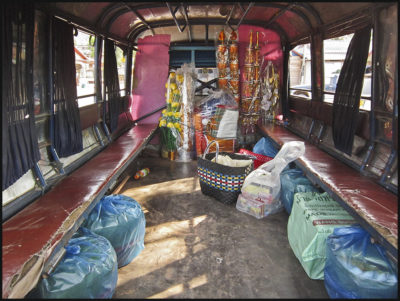
Sorgntaaou transport…pronounced songtau.

Rental motorbikes are available everywhere.
In Thailand, however, we prefer to drive ourselves. Car rental is very reasonable, cars are in good repair, roads are good, and the tourist infrastructure well developed. People are very friendly and helpful. With a phrase book, a good map, some universal hand signals and a willingness to let things happen as they happen, self-driving is the best. Parks that are very difficult to get to by public transport are easily visited. If you want to see birds and wildlife, this is the way to go.
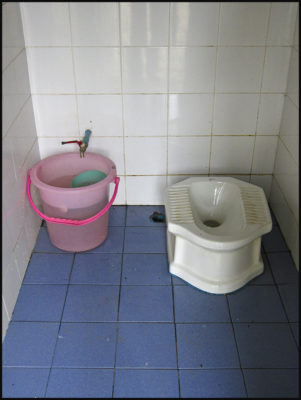
A tidy toilet.
There are still many bathrooms featuring squat toilets. Rarely will toilet paper be provided… except as napkins from a little TP dispenser on the table in restaurants; a source of constant amusement for us. Toilet paper is available at 7-Elevens and other shops so you don’t need to bring it from home. Beds are generally quite hard so fitting a small sleep pad in your luggage is a real bonus. Pack as lightly as possible, especially if taking public transport.
Traveling in these countries is rewarding. Despite any negative things we have mentioned, the overall experience is wonderful. You can stay at 5-star hotels anywhere in the world and never face the least inconvenience or you can go the budget route and truly see how other cultures live. Travel in these countries is extremely to very economical depending on the desired level of amenities.
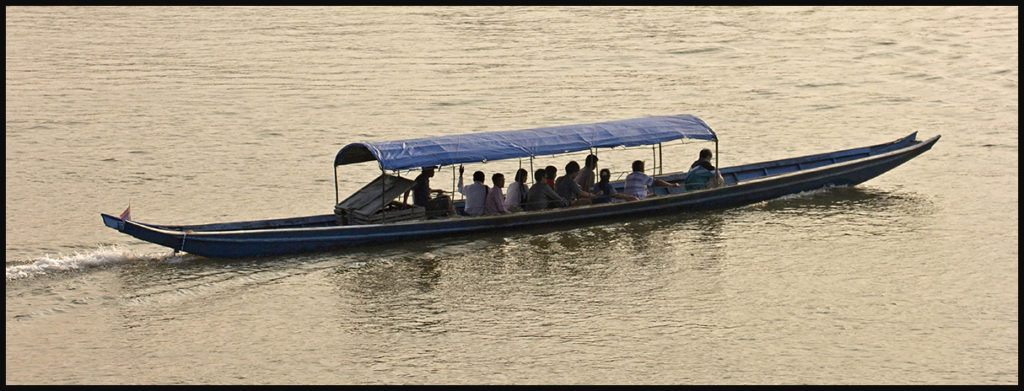
Crossing the Mekong between Thailand and Laos.
One more bit of advice. For the border crossings it is imperative to have American dollars. Also some extra passport photos are needed.
Tropical countries around the world (except northern Australia) share similar economic disparities and rewards which is what makes visiting them so interesting and educational. We hope many of you agree and find the time and energy to explore on your own.
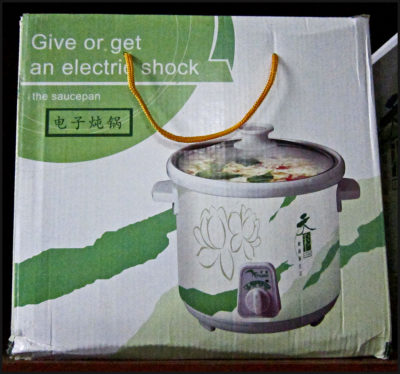
Lost in translation by the marketing department.

Tourists at Angkor Wat.
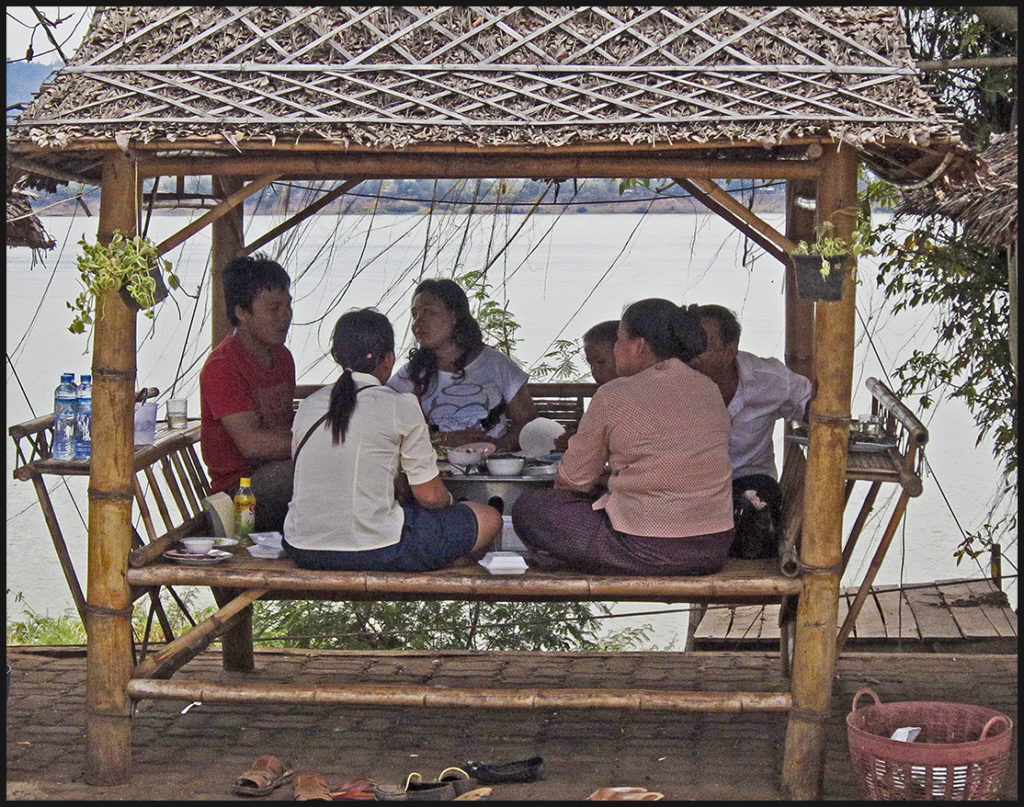
Family enjoying the day out at a riverside restaurant.
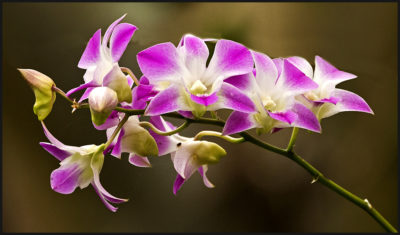
Orchids are found in every eco-niche.
Heliconia.
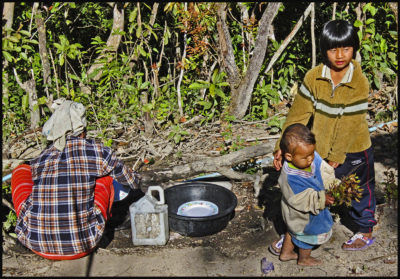
Village scene.
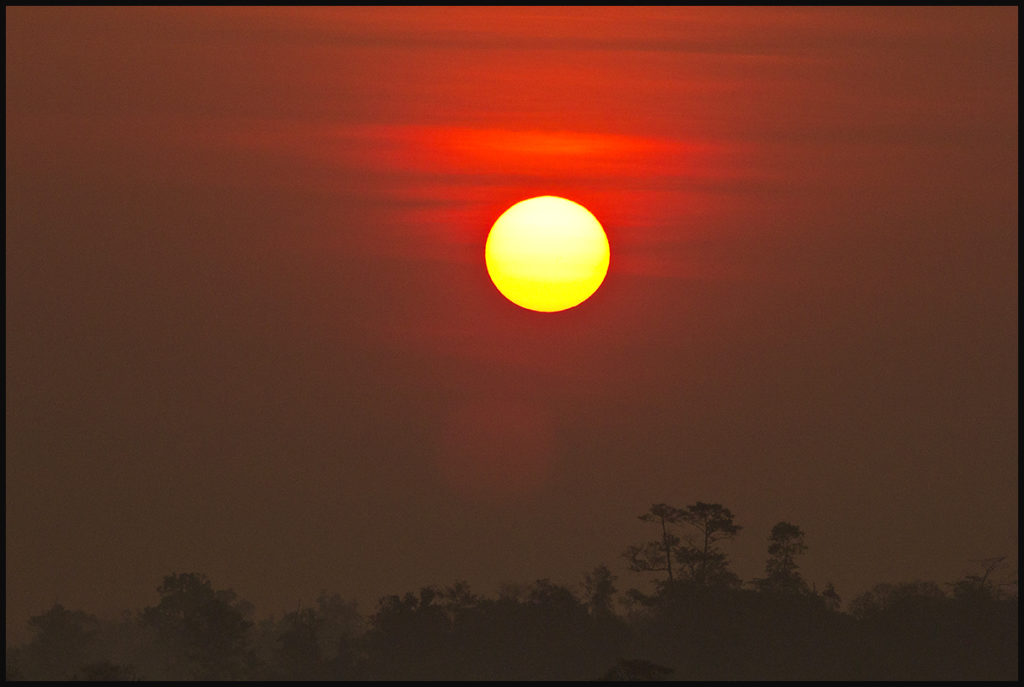
Good-bye, SE Asia. It was a lovely visit.
